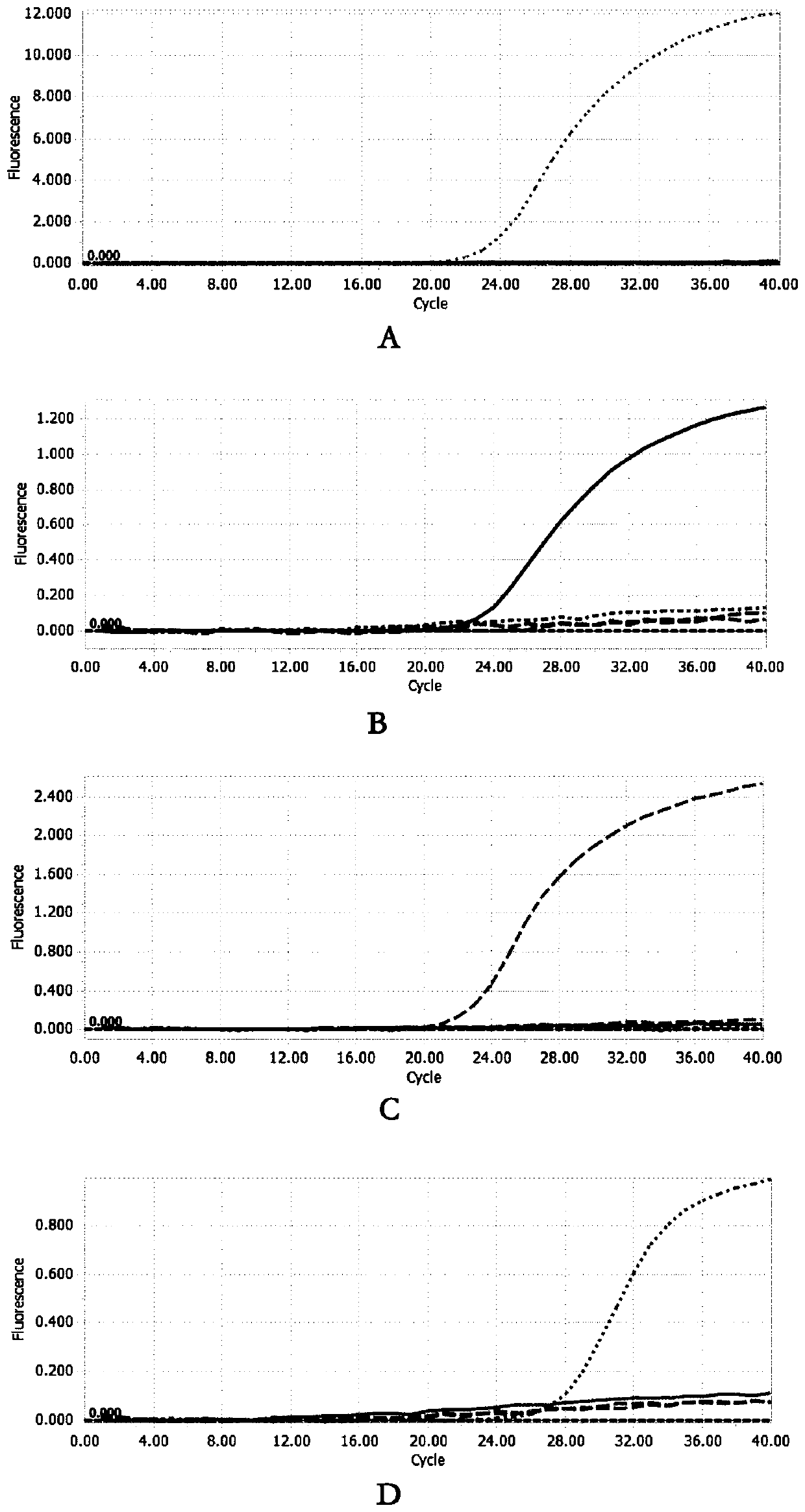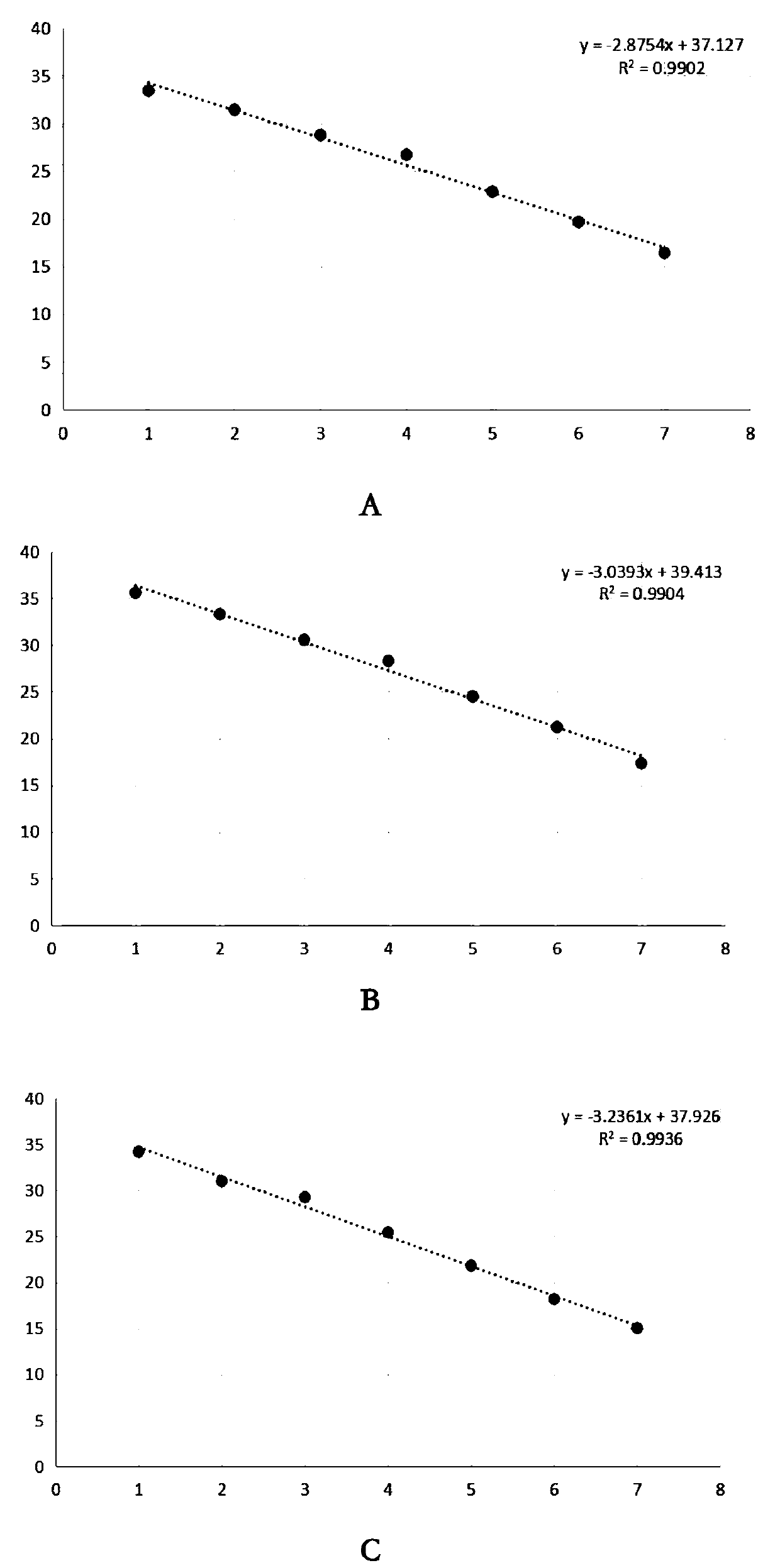Multiplex fluorescence quantitative PCR detection primer and probe combination and detection method for simultaneously detecting four duck-susceptibility viruses
A multiplex fluorescence quantitative and detection method technology, applied in the multiplex fluorescence quantitative PCR detection primer and probe combination and detection field, can solve the problems of high virus purification requirements, long time, lack of PCR sensitivity, etc., to achieve good repeatability, Detection of high sensitivity and specificity
- Summary
- Abstract
- Description
- Claims
- Application Information
AI Technical Summary
Problems solved by technology
Method used
Image
Examples
Embodiment 1
[0041] Primer design and screening
[0042] According to the conserved genes of each virus in GenBank, the fusion protein gene (F gene) of NDV, the matrix protein gene (M gene) of AIV, the nucleocapsid protein gene (VP1 gene) of DHAV, the envelope protein gene (E gene) of DTMUV ), using DNAMAN software for homology analysis, using Primer Premier5.0 software, designing specific probes in its conserved regions, and labeling FAM, JOE, ROX, Cy5 and other fluorescent emitting groups at the 5' end, and at the 3' BHQ1 or BHQ2 fluorescence quenching group is labeled at the end, and at the same time, according to the position of the probe, two or more primers are designed for each virus for screening, and primers with good specificity, no cross-reaction and good amplification efficiency are selected. The virus-specific primers and probes are listed in Table 1.
[0043] Table 1
[0044]
[0045]
Embodiment 2
[0047] Plasmid standard preparation
[0048] Step 1: Primer Synthesis
[0049] The 4 pairs of virus plasmid construction primers designed by the present invention are shown in Table 2, and were synthesized by Nanjing GenScript Biotechnology Co., Ltd.
[0050] Step 2: Total viral RNA extraction
[0051] According to the instructions of the Viral RNA Extraction Kit kit, four kinds of viral RNA were extracted respectively, and the reverse transcription step was performed immediately.
[0052] Step 3: Reverse transcription PCR
[0053] Add 1 μl of NDV, AIV, DHAV, and DTMUV RNA to an RNase-free PCR tube, and use ThermoScientific RevertAidFirstStrand cDNASynthesisKit for RT-PCR reaction, including 4μl of 5xBuffer, 2μl of 10mM dNTP, 1μl of Random Primers, 1μl of 20U / μl Ribolock RNase, 200U / μl ReverAid M-MuLVRTase 1μl, DEPC water 10μl, total system 20μl, cDNA was obtained after the reaction.
[0054] Step Four: PCR Amplification
[0055] 50μl PCR reaction system: 5μl 10x taq buff...
Embodiment 3
[0061] Primer specificity verification
[0062] Use the standard plasmids constructed by the four viruses as templates to amplify the corresponding target fragments. Each reaction system is 20 μl, including 10.0 μl of 2x SYBR Green, 0.4 μl of upstream and downstream primers, 1 μl of a single virus plasmid template, and deionized water to make up 20μl; the reaction program is: 95°C for 3min, 95°C for 10s, 54°C for 30s, after 40 cycles, add a melting curve program: 95°C for 10s, 60°C for 30s, and 97°C for 1s. The specificity was 100%.
PUM
 Login to View More
Login to View More Abstract
Description
Claims
Application Information
 Login to View More
Login to View More - R&D
- Intellectual Property
- Life Sciences
- Materials
- Tech Scout
- Unparalleled Data Quality
- Higher Quality Content
- 60% Fewer Hallucinations
Browse by: Latest US Patents, China's latest patents, Technical Efficacy Thesaurus, Application Domain, Technology Topic, Popular Technical Reports.
© 2025 PatSnap. All rights reserved.Legal|Privacy policy|Modern Slavery Act Transparency Statement|Sitemap|About US| Contact US: help@patsnap.com



